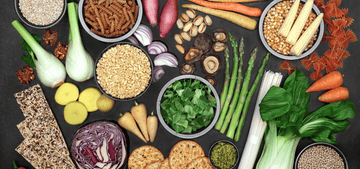Plant-based muscle building is challenging, but it’s far from impossible, and with a little knowledge and preparation, you can reach all of your size and strength goals just as easily as you could on an omnivorous diet.
Whether you’re a novice lifter and recent vegan seeking a comprehensive skillset, or an experienced plant-based bodybuilder pursuing an edge, the following guide will help.
Plant-Based Meal Planning
When it comes to building muscle, the kitchen is just as important as the gym; what you eat has as much impact as what you lift. This is true for every diet, but it’s especially true for vegan bodybuilding.
You have all of nature’s bounty at your disposal, so eat varied meals and be sure to include all of the following:
A quality protein
Research suggests that 1.6g of plant-based protein per 1kg of body weight is more than enough for optimal muscle growth. That’s equivalent to around 0.7g protein per pound of body weight.(1)
So, if you weigh 200 lbs. (90.7kg), that’s 140g of protein. If you eat 5 meals per day, you should look to consume an average of 28g per meal.
Of course, it doesn’t need to be exact. It’s okay to go over or under. Treat this number as a vague milestone as opposed to a strict goal.
Some of the best plant-based protein sources include:
- Seitan = 24g protein per 100g serving (source)
- Tempeh = 20.3g protein per 100g serving (source)
- Edamame = 18.4g protein per 1 cup serving (source)
- Lentils = 17.9g protein per 1 cup serving (source)
- Black beans = 15.2g protein per 1 cup serving (source)
- Chickpeas = 14.5g protein per 1 cup serving (source)
- Tofu = 12.7g protein per 100g serving (source)
- Green peas = 8.5g protein per 1 cup serving (source)
- Nutritional yeast = 8g protein per 16g serving (source)
Grains like amaranth and quinoa, as well as spirulina, hemp seeds, chia seeds, and nuts are also good plant-based protein sources.
A complex carb
Carbs are not the enemy. They provide fuel and nutrients. Just as importantly, they will help you to meet your calorie needs. Although it is possible to build muscle while maintaining or even losing weight, there is a limit. If you lead an active lifestyle and spend a lot of time in the gym, your body might be burning over 3,000 calories a day.
So, in addition to leafy green vegetables, root vegetables, and fruit, stock up on grains (brown rice, quinoa), oats, and corn. There’s nothing wrong with a little wholegrain bread or even some tortillas.
Healthy fats
Unsaturated fat and polyunsaturated fat (as found in avocados, olive oil, and sunflower oil) are healthy and should be included in a balanced plant-based diet.
If using oils, remember that cold-pressed and uncooked are best. Don’t shy away from salad dressings if that’s what you like, and look into ahiflower oil, chia seeds, hemp seed oil, and flaxseed oil to ensure you consume a good balance of omega 3 and omega 6 fatty acids.
Something fresh
The pigments responsible for giving fruits and vegetables their unique colors are often potent antioxidants. Lycopene gives tomatoes, watermelon, and grapes their rich red color and also supports heart health. Anthocyanins give many fruits, vegetables, and flowers a distinctive purple or blue color and may help with diabetes and support vision health. And these are just two of the many examples.(2)(3)
Eat the rainbow—and no, that’s not an invitation to binge on Skittles!
What about fiber?
Fiber is essential, and adequate consumption has been linked with improved cardiovascular outcomes and numerous other benefits. However, it’s thought that 95% of Americans aren’t eating enough.(4)(5)
You definitely need fiber, and the American Heart Association (AHA) recommends consuming between 25g and 30g a day. But the great thing about plant-based diets is that you’ll often find yourself exceeding those recommendations without trying.(6)
There’s very little fiber in meat, cheese, and processed food, and these foodstuffs are also energy-dense, so many Americans meet their daily calorie needs without getting anywhere near those fiber recommendations. But if you eat lots of complex carbs, fruits, and vegetables, it shouldn’t be an issue.
Take a look at the following calorie-fiber ratios as an example:
- Pears = 7g fiber per 145 calories (source)
- Split peas = 16.3g fiber per 227 calories (source)
- Lentils = 10.7g fiber per 352 calories (source)
- Oats = 10g fiber per 389 calories (source)
- Raspberries = 6.5g fiber per 52 calories (source)
- Brussels sprouts = 3.8g fiber per 43 calories (source)
- Broccoli = 2.6g fiber per 34 calories (source)
As long as you’re eating enough calories and not resorting to copious amounts of sugary drinks, candies, and fried food, fiber won’t be an issue.
What about vegan protein supplements?
There’s nothing wrong with supplements and they are common across the vegan bodybuilding community. The key is to make sure they are supplementing your diet and not being used in place of real foods or hard work.
BCAAs are a great addition, as are healthy oils and powders designed with overall well-being in mind. Avoid anything that overpromises, makes outlandish claims, or contains untested, unproven, and potentially harmful ingredients.
Your Plant-Based Workout Routine
Vegan fitness nutrition is incredibly important, but it’s obviously just one piece of the puzzle. You also need to give it your all in the gym.
Here are some tips to keep in mind when creating your workout routine:
- Eat a carb-heavy pre-workout meal: Although it’s not essential for the average gym-goer, it’s a good idea to fuel your workout with plenty of carbs. Include protein as well, with a ratio of about 3:1 (3g carbs for every 1g protein), but don’t eat so much that you’ll have cramps for hours afterward. Eat about 2 to 3 hours before working out.
- Start slow: If you’re new to working out, start slowly. This is especially important if you are overweight or unfit. Going too heavy could leave you with DOMS for days, and that may hurt your motivation and hinder your progression. Try yoga, long walks, stretching, or resistance bands, and build from there.
- Do what you enjoy: Don’t force yourself to do something you don’t like, especially in the beginning. Find something you enjoy, whether it’s bench pressing and squatting or swimming and using medicine balls.
- Stay hydrated: Drink plenty of water while you work out. Don’t worry too much about intra-workout shakes, energy drinks, and all those neon-colored, sugar-rich beverages sold at your local gym. Water is more than sufficient.
- Don’t be scared of rest: Your body needs time to rest and will often grow and recover in those rest times. Working out every other day or even just 3 times a week is sufficient for most people, and if you’re tired or hurting, you should extend those rest periods.
- Listen to your body: If you feel that something’s not right, whether it’s tiredness or pain, take a break and get it checked out. The last thing you want is to get struck down by illness or injury caused by overexertion.
- Eat a big meal afterward: There is no “anabolic window”, so you don’t need to worry about eating protein while you exercise or immediately afterward. But eating a big meal an hour or so after can help with recovery. It’s also very satisfying!
Muscle growth tips for vegans
Before I finish, here are some quick vegan fitness tips to ensure you’re adequately prepared:
- Check your basal metabolic rate so you know how many calories you’re burning at rest.
- Watch videos, read blogs—there’s always something more to learn.
- Take a break when you’re injured, tired, or unwell.
- Try to make your workouts fun—listen to music/podcasts, workout with friends.
- Don’t rely too much on supplements.
- Pay more attention to food labels; know what you’re eating.
- Keep a food journal and monitor your protein, fat, carb, and nutrient intake.
- Document your progress with pictures. It’s great motivation.
- Make a note of your personal best (weights, times, reps, etc.,)
- Write down your motivations or put pictures in your workout space.
Summary: The Best Plant-Based Muscle Recovery
Now you have some vital information, you’re ready for hardcore plant-based muscle building!
Remember, focus on your diet, eat balanced meals, meet your calorie and protein needs, and work hard in the gym. It’s a simplified way of looking at vegan bodybuilding, but simple is good, it works, and it’s all you need!
References
Conclusion: “A high-protein (~ 1.6 g kg-1 day-1), exclusively plant-based diet (plant-based whole foods + soy protein isolate supplementation) is not different than a protein-matched mixed diet (mixed whole foods + whey protein supplementation) in supporting muscle strength and mass accrual, suggesting that protein source does not affect resistance training-induced adaptations in untrained young men consuming adequate amounts of protein.”
Link: https://pubmed.ncbi.nlm.nih.gov/33599941/
Conclusion: “The proven positive effect of lycopene on cardiovascular diseases is known. The reasons for this effect can be attributed to the positive effects of lycopene on serum lipid levels, their reduction of endothelial dysfunction, positive effects on inflammation, their help in blood pressure regulation, and antioxidative effects.”
Link: https://www.ncbi.nlm.nih.gov/pmc/articles/PMC8626194/
Conclusion: “Anthocyanins are the value-added colorants that can be used for preventing several diseases, including CVDs, cancers, diabetes, some metabolic diseases, and microbial infection.”
Link: https://www.ncbi.nlm.nih.gov/pmc/articles/PMC5613902/
Conclusion: “…there are clear associations between dietary fibre intake and multiple pathologies that include cardiovascular disease, colonic health, gut motility and risk for CRC.”
Link: https://www.ncbi.nlm.nih.gov/pmc/articles/PMC7589116/
Conclusion: “an estimated 95% of American adults and children do not consume recommended amounts of fiber.”
Link: https://www.ncbi.nlm.nih.gov/pmc/articles/PMC6124841/
Conclusion: “The AHA recommends a total dietary fiber intake of 25 to 30 g/d from foods, not supplements, to ensure nutrient adequacy and maximize the cholesterol-lowering impact of a fat-modified diet.”
Link: https://www.ahajournals.org/doi/full/10.1161/01.CIR.95.12.2701





